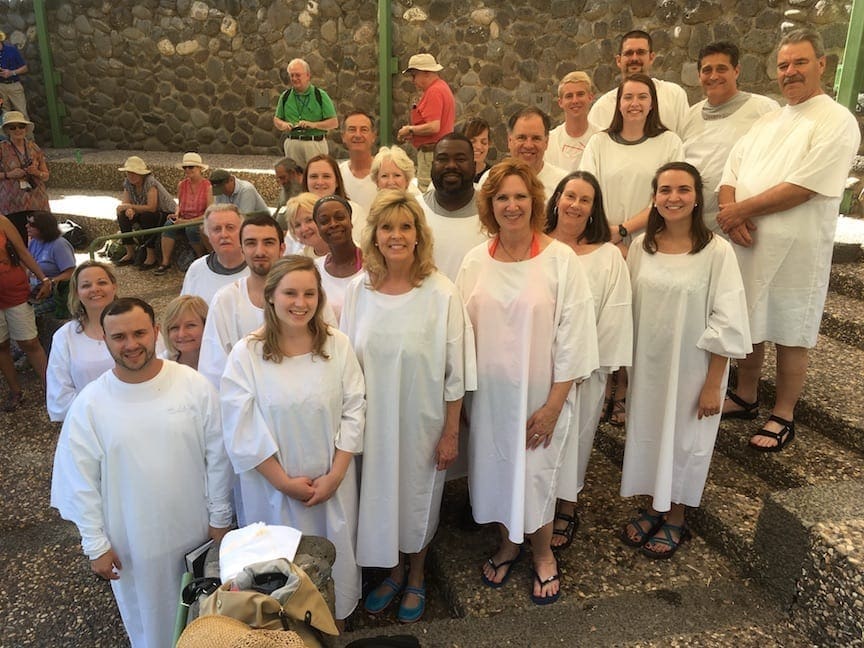Participants in the Campbell University Divinity School/Nurturing Faith Experiences tour packed two days’ worth of experiences (for many groups) into one day on Monday, May 15.
The day began on the Mount of Beatitudes, where Peter Donlon, Alumni and Development Director for CUDS, led us in a morning devotion as we overlooked the Sea of Galilee.
Our next stop was Hazor, one of the two major cities in Galilee during the Bronze and early Iron Ages. At Hazor we passed through a gate dated to the Israelite period, noted the casemate walls, and pondered the remains of a large mud-brick structure from the earlier Canaanite period. It is usually thought to be a palace, though the courtyard features a large square altar. Part of the group ventured down a deep water shaft to examine the city’s system for obtaining water, and we also took note of an Israelite storage building and house (with a small olive press in the courtyard) often dated to King Ahab’s time.
From Hazor we drove north through the Hula Valley, crossed the stream called Senir (one of the three tributaries feeding the Jordan River) and visited Dan, a Canaanite city known as Laish before the tribe of Dan – which wasn’t able to take its assigned territory from the Philistines – migrated north, conquered that city, and renamed it Dan. Dan is mentioned in Genesis 14 as the extent to which Abraham reportedly pursued the coalition that had captured his nephew Lot (along with other people from Sodom). As a result, an old Canaanite gate from that period is called “Abraham’s gate,” though he almost certainly had nothing to do with it. The gate was notably constructed of three arches made of mud brick – more than a thousand years before the Romans supposedly invented the arch.

Participants listen to a talk about Jeroboam’s temple at Dan — while sitting on the steps of what might have been it.
Old Testament students are more likely to remember Dan as one of two cities (the other was Bethel) where the northern kingdom’s first king – Jeroboam the son of Nebat – established temples containing golden calves to keep his citizens from going to Jerusalem for worship.
Our visit to Dan included a delightful walk along a nature trail leading along the Dan Spring – the largest of the three sources of the Jordan River (“Jordan” means “the Dan descending”).

Stephanie Bohanon leads a devotion based on the story of Jesus, at Caesarea Philippi, asking his disciples “Who do you say that I am?”
After Dan, we drove to Banyas (or Panyas), adjacent to Caesarea Philippi, where Greeks and Romans used to worship the nature god Pan, along with a variety of other favorite gods. Christians are more likely to remember the place as the area where Jesus asked the disciples “Who do you think that I am?” and congratulated Peter for recognizing him as the Messiah. A spring emerging from the cliff face at Banyas is the third tributary to the Jordan.
All of that was before lunch – which we enjoyed at Birkat Ram, a restaurant in the Druze village of Masa’ade that features “Druze Pita,” falafel, and other local favorites.
We drove south through the Golan Heights, stopping briefly at the “Valley of Tears,” a memorial to Israeli soldiers who died in a 1973 war against Syria. Continuing south along the eastern side of the Sea of Galilee, we came to Yardenit, a beautiful baptismal site on the Jordan River.
There 25 members of our group participated in a ceremony to remember their baptism.
Enough, right? Not for us. On we went, north along the western side of the Sea of Galilee, through Tiberias, and on to the site of ancient Migdal (or Magdala), a fishing town that was home to Mary Magdalene. The site dates to the time of Jesus, and is notable for the discovery of a synagogue where it is likely that Jesus would have taught.
That synagogue featured a one-of-a-kind find: a carved stone block that many believe was intended to depict the Jerusalem temple. Though we were able to view two reproductions of the stone, the original is currently on display at the Vatican as part of a joint exhibition related to the Jewish Menorah.
We could have stayed longer, but it was time for dinner and some good rest before another busy day tomorrow. Fortunately, our hotel was only a couple of miles away, and dinner was waiting.








